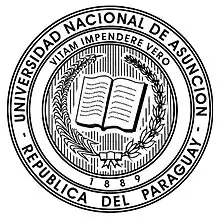Universidad Nacional de Asunción
The Universidad Nacional de Asunción or Mbo'ehaovusu Tetãgua Paraguaygua, abbreviated UNA, anglicized as, The National University of Asuncion, is a public university founded in San Lorenzo, Paraguay. Founded in 1889, it is the oldest and most traditional university in the country.[1]
 | |
| Motto | Vitam Impendere Vero |
|---|---|
| Type | Public |
| Established | 1889 |
| Rector | Pedro Gerardo González |
| Location | , , |
| Website | www.una.py |
History and evolution
When the university first started, it consisted of only the Faculties of Law, Medicine and Mathematics, and schools of Clerical, Pharmacy and Obstetrics.
As of 2015, the UNA had 12 faculties and a number of institutes in 74 careers that take place in different areas of knowledge, offering students the most comprehensive range of vocational training opportunities. The academic community is made up of about 40,000 students and 6,200 teachers.
It also has several technology centers and research facilities for the academic community, both for conducting scientific research, and for the development of postgraduate studies, resulting in contributions to society.
Organization
The university campus is spread throughout Paraguay, with centers in Pedro Juan Caballero, Caacupé, San Juan Bautista, Santa Rosa Misiones, Caazapá, Villarrica, Coronel Oviedo, Caaguazú, Paraguarí, Villa Hayes, San Pedro, San Estanislao, Cruce Los Pioneros (Boquerón) and Benjamín Aceval, in addition to the main campus in San Lorenzo and institutes in Asunción.

Schools
UNA currently has twelve Schools:
- School of Chemical Sciences
- School of Medical Sciences
- School of Dentistry
- School of Engineering
- School of Law and Social Sciences
- School of Economic Sciences
- School of Philosophy
- School of Agrarian Sciences
- School of Veterinary Sciences
- Polytechnic School
- School of Architecture, Design and Art
- School of Exact and Natural Sciences
Institutes
- Institute of Arts
- Institute of Languages
- Institute of Social Work
Publications
In the 2020s, the Higher Institute of Languages started publishing Ñemitỹrã, an academic journal on language, society, and education.[2]
Notable alumni
- Eusebio Ayala, President of Paraguay
- Fatima Mereles
- Vicente Pistilli
Partner universities
See also
References
- The National University of Asuncion, Brief History, October 26, 2010
- "Ñemitỹrã" (in Spanish). Retrieved 27 June 2022.